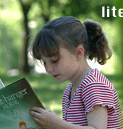This section examines teaching one of the conventions of literacy,
the letter patterns used to write (that is, spell) words. The sequence
in which readers learn to read particular types of letter patterns
in shown in the following table. This sequence indicates the order
in which they need to be taught.
A key aspect of development here is for readers to learn to read
longer, more complex clusters of letter at once.
There are two types of letter cluster knowledge students need to
learn for each type of pattern:
Each awareness involves students being able to:
| Type of pattern |
Example |
| Awareness of individual letter-sound patterns |
Individual sounds map into a letter
Each letter has a name |
| A short string of letters can be recoded to spoken word |
Recode words with c-short vowel-c
Each letter linked with a sound
Example: hot, cat, dog |
| Consonant clusters processed at once; a letter-cluster
and matching sound pattern shared by several words |
Develop first for onsets and rimes in 1-syllable word
Example: 'hot' as h-ot and 'stop' as st-op |
| One-syllable simple word structure |
Readers learn to recognise letter strings that have the consonant-vowel-consonant
or cvc pattern (for example, dig, pet), the ccvc pattern (for
example, stop, plug) and the cvcc pattern (for example, sump,
post) |
| Two or more consonants can be linked with the one sound |
Example: Patterns - shell, chop, them |
| Words with long versus short vowel sound |
Two types of sounds associated with vowels; long and short
vowel sounds |
| Vowel-vowel and vowel-consonants digraphs |
Example: tree, seem, star, far |
| Different letter groups linked with same sound |
Example: the long 'a' sound is linked with 'ay', 'ai', or
'a-e' as in may, main & mate |
| Same letter cluster can be linked with different sound |
Example: stool versus foot, farm versus fare |
| One-syllable more complex form of digraphs and trigraphs |
Example: knight, enough |
| Syllables and syllable-like units |
Example: con + cert, in + side, out + side |
| 'Silent letters' |
Example: write, lamb, know |
| How to read two-syllables, one after the other |
Example: button |
| Stress patterns in two-syllable words |
|
| Two-syllable word structure |
|
| Letters surrounding a letter influence how it is said |
Options for pronouncing 'g' - gentle, grid
Options for pronouncing 'c' - cigar, current |
| Letter cluster - meaning patterns |
Example: micro, phone |
| How meaning is carried by particular letter clusters |
Example: adding 'ing', 's' or 'ed' to a verb |
| Syllabic structure of multi-syllabic words |
Example: prefixes, suffixes and root words that aren't said
how they are written; tion, ance, ble, er |

